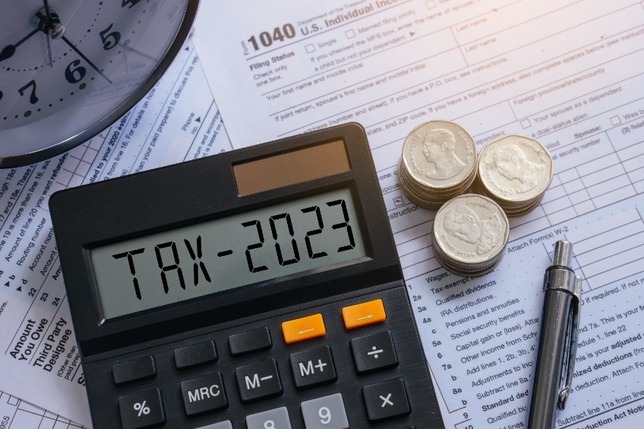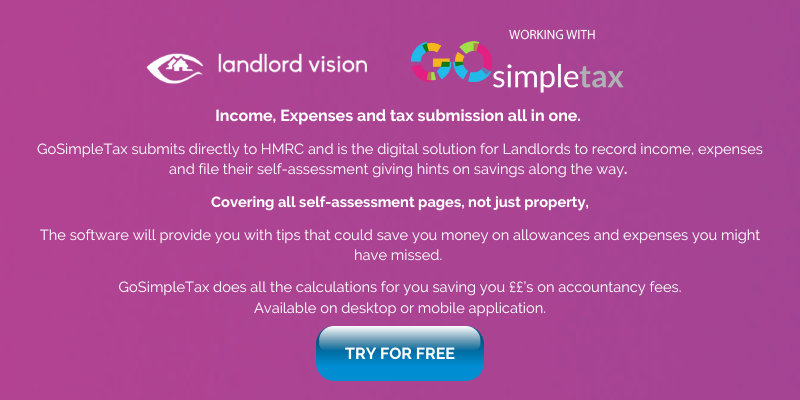
So, you’ve recently joined the ranks of the UK’s 2.6m private residential landlords and need to report taxable rental income via Self Assessment?
It’s natural to be worried about having to complete your first Self Assessment tax return. As the online filing deadline (midnight 31 January) moves closer, you may soon start to dread the thought of it.
However, gaining some basic knowledge and completing your Self Assessment tax return is simple enough and certainly nothing to worry about (as long as you don’t leave it too late). Each year, more than 12.2m Self Assessment tax returns are filed and many are completed by landlords like you.
You don’t need to be an accountant or pay one to complete your Self Assessment tax return, you can do it yourself. But before you try to complete your first Self Assessment tax return – to make the task quicker, cheaper and easier for you – here are 21 things you should know from GoSimpleTax.
The First Step for Landlords is to Register for Self Assessment
1 To pay Income Tax on rental income, most landlords register for Self Assessment. Self Assessment is the system that the UK tax authority HMRC uses to collect Income Tax.
2 You can register for Self Assessment via the government website GOV.uk After registering online, within 10 days (21 if you live overseas), you will get a letter through the post with your Unique Taxpayer Reference (UTR) number. You need it to file your Self Assessment return.
3 You’ll need a Government Gateway user ID and password to sign into your business tax account to complete your Self Assessment tax return. If you don’t have one, getting a user ID via GOV.uk is straightforward.
Need to know! You should contact HMRC if your property rental income is between £1,000 and £2,500 a year. You must report your rental income via Self Assessment if it’s between £2,500 and £9,999 after allowable expenses (see below) or £10,000 or more before allowable expenses.
How to File Your Self Assessment Tax Return
4 You can complete and file your Self Assessment tax return as soon as the tax year ends on 5 April. It’s best to get it done long before the online filing deadline (midnight on 31 January).
Need to know! If you would prefer to download and fill out a paper tax return – something that only about 4% of people still do – the filing deadline is 31 October. Filing online is much quicker, easier and more convenient, with mistakes much less likely.
5 You’ll probably have to pay a penalty and interest if you do not file your Self Assessment tax return and pay any tax you owe when required.
6 Once registered, if you choose to file online (as more than 95% of people do) you can file directly with HMRC via Government Gateway or you can use third-party commercial software.
7 Using Self Assessment software can save you lots of time and money. It can ensure that you enter all of the necessary information in the right places within your tax return. Automatic prompts prevent mistakes and the support you receive can ensure that you claim all of the tax allowances and reliefs to which you’re entitled (see below).
Need to know! If you miss the midnight 31 January online filing deadline and don’t have a reasonable excuse, you’ll be charged a £100 penalty. Your fine will increase if you still haven’t filed after three months.
The Self Assessment Tax Return
8 Landlords must complete the main Self Assessment tax return (SA100), as well as a supplementary page (SA105) that summarises their taxable rental income and costs.
9 The SA105 form is just two pages long. You can download it from the government website GOV.uk. HMRC also publishes guidance for landlords on how to fill out the SA105 supplementary page.
10 You may need to complete and file other supplementary pages if you have other taxable income to report, for example, SA103S or SA103F if you also earn taxable income from self-employment.
11 Within the SA100, you provide details of taxable income, as well as student loan repayments (if applicable), taxable bank or building society interest, pension payments, annuities, donations to charity, and tax reliefs and allowances that you wish to claim.
Self Assessment Allowable Expenses for UK Landlords
12 Landlords can claim for many costs they incur to be able to rent out their property. Such “allowable expenses” can include: letting agents fees; legal fees (for lets of a year or less) or for renewing a lease for less than 50 years; accountancy fees; buildings and contents insurance; property maintenance and repairs (but not improvements); utility bills if you pay them; ground rent and service charges; Council Tax; cleaning or gardening; other direct costs relating to renting out your property, such as phone calls, stationery, advertising, travel, etc.
- Visit the government website GOV.uk for more information on landlord allowable expenses or check out Landlord Vision’s Allowable Expenses checklist.
13 If you use something for personal and rental reasons, for example, your mobile phone, you can only claim allowable expenses for the rental cost proportion. You’ll need to use a reliable method to work out how much to claim.
14 You may be able to claim tax relief when you spend money replacing a domestic item, for example, a bed, sofa, curtains, cushions, carpets, fridge, crockery, cutlery, etc. This is called ‘replacement of domestic items relief’. You must have bought the item for use by tenants in your residential property to replace something that’s no longer usable by them.
15 If you’re not sure whether a cost is allowable, contact the Self Assessment helpline. You can’t claim allowable expenses if you claim the £1,000 tax-free property allowance, which is advised if your expenses are below £1,000.
Completing Your Self Assessment Tax Return
16 According to Which?, on average, it takes about two and a half hours to complete a Self Assessment tax return. And while more experienced people (about 20%) can get it done in less than an hour, it takes as long as five hours for 10% of Self Assessment taxpayers. Some people do it in one session, while others do it in two or three.
Top Tip! Before starting, read HMRC’s guidance on the SA100 and SA105 so that you better understand what information you need to enter.
17 Before you start to fill in your Self Assessment tax return, to complete the task much sooner, have the following to hand:
- your ten-digit Unique Taxpayer Reference (UTR)
- your National Insurance number
- details of your income from the tax year (e.g. rental income, as well as any from self-employment, dividend payments, interest, rental income, etc.)
- categorised summaries of rental costs you wish to claim as allowable expenses
- contributions to charity or pensions that might be eligible for tax relief.
Having all of your rental income and costs neatly summarised already in accounting software will save you a lot of time when it comes to filling in your Self Assessment tax return.
Top Tip! If you also receive income from part-time or full-time employment, have your P60 to hand. Even though you’ve already paid tax on it, you need to include your employed income in your SA100, so that your overall tax liability can be calculated.
18 Don’t rush when filling out your Self Assessment tax return, otherwise you’re more likely to make mistakes. Pick a time and a place where you’ll be free from distractions, so you can concentrate fully on the job at hand.
19 You can file your Self Assessment tax return any time after 6 April, so don’t leave it until the week before the online filing deadline (midnight on 31 January).
20 If you file online but suddenly realise that you’ve made a mistake in your Self Assessment tax return, you’ll have to wait three days (72 hours) to correct it. But you can amend figures up to 12 months after the filing deadline.
How Much Tax Will You Pay as a UK Landlord?
21 Your tax bill will be based on the figures you’ve reported in your Self Assessment tax return and the Income Tax into which your total taxable income falls.
- Thanks to the Personal Allowance, you don’t pay any Income Tax on the first £12,570 of your income, provided that you don’t earn more than £125,140 in a tax year. This is in addition to other tax reliefs and allowances that you can claim.
- The 20% Basic Rate of Income Tax is payable on income between £12,571 and £50,270. The 40% Higher Rate of Income Tax is payable on income between £50,271 and £150,000. The 45% Additional Rate of Income Tax is payable on earnings of more than £150,000 a year (*Income Tax bands are different in Scotland).
- Because you’re not running a professional property business, merely renting out property that you own, no National Insurance contributions are payable.
The deadlines for paying your tax bill are 31 January for any tax you owe for the previous tax year (it’s called a “balancing payment”) and your first “payment on account” (advance payments towards your tax bill), then 31 July for your second payment on account.
- Visit the government website GOV.uk for more guidance on your responsibilities as a landlord.




